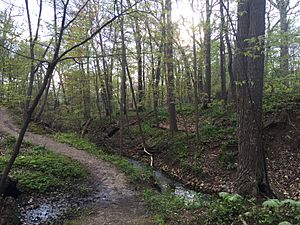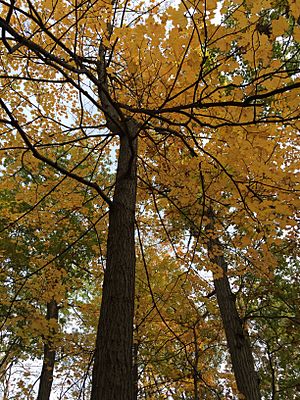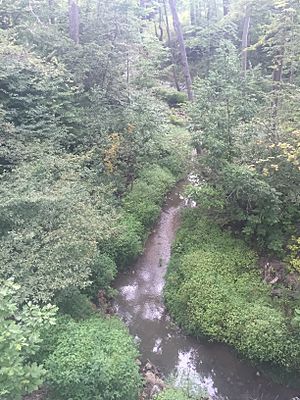Ravine Park facts for kids
Quick facts for kids Ravine Park |
|
|---|---|

The main path within the park
|
|
| Lua error in Module:Location_map at line 420: attempt to index field 'wikibase' (a nil value). | |
| Location | Lake Bluff, Illinois, USA |
| Area | 14 acres (5.7 ha) |
| Operated by | Lake Bluff Park District |
| Status | Open all year |
| Threatened by | Invasive species, erosion |
Ravine Park is a special community park found in Lake Bluff, Illinois. It covers about 14 acres (5.7 hectares) of land. The park's main feature is a deep valley, called a ravine. This valley was created by a stream that flows only after heavy rain. When it's not raining, the stream turns into a series of muddy ponds.
The best part of Ravine Park is its small network of nature trails. These trails let you explore the park's natural beauty. Ravine Park is one of the few protected ravines in all of Lake County, Illinois. It offers a peaceful home for plants and animals in the busy Chicago suburbs.
How Ravine Park Was Formed
Ravine Park gets its name from the deep valley it holds. This park is one of about thirty such ravines found along the North Shore of Chicago. These valleys formed a long time ago, about 12,000 years ago.
They appeared after the last giant glacier, called the Laurentide Ice Sheet, melted away. As the ice melted, water flowed from the high hills (called moraine bluffs) north of Chicago into Lake Michigan. This flowing water carved out the ravines.
Ravines in northeastern Illinois can be very deep, sometimes up to 75 feet (23 meters). They can also stretch far inland, up to 2 miles (3.2 kilometers) from the lake. The ravine in Ravine Park is about 3,500 feet (1.1 kilometers) long. At its deepest, it is about 30 feet (9.1 meters) deep.
However, only about half of this ravine is easy to walk through. The rest has very steep sides and thick plants. Ravine Park covers most of this valley. Only a very small part at the end is on private land.
The ravine faces a big problem called erosion. This means that soil and dirt are washed away by water. Each year, hundreds of tons of sediment flow from the ravine into Lake Michigan. To help with this, a large restoration project took place from 2010 to 2013. This project helped reduce the amount of sediment flowing into the lake by about 300 tons each year.
During the project, parts of the ravine were strengthened with stone and native plants. Workers also removed invasive plants that don't belong there. They also fixed pipes that carry storm water.
Park History
Even before Lake Bluff became a village, the ravine was a popular spot. Paths and benches were added so summer visitors could enjoy the beautiful nature. In 1895, the area officially became part of the village. The Village Board managed it until 1928.
After the first Fourth of July parade in 1911, a group decided to improve the village. They wanted to turn the ravine into a botanical garden. A Park Commission was created. They found 64 different types of trees in the ravine. Soon after, they built a nature path through the area.
The Lake Bluff Park District was formed in 1925. In 1928, they took over control of Ravine Park. The Park District has continued to take care of the park ever since.
Plants and Animals in Ravine Park

The ravines along the North Shore are home to deciduous forests. These are forests where trees lose their leaves in the fall. The wind and cool air from Lake Michigan keep the ravines cooler than the surrounding areas. Because of this, the forests here are similar to those found in colder, more northern places.

In Ravine Park, you'll mostly see sugar maples, basswood, and red oaks. Other trees are also present, including the Norway maple, which is an invasive plant. The smaller plants growing on the forest floor include Virginia bluebells, mayapple, and trillium. You might also spot some American witch-hazel.
Common animals in Ravine Park include white-tailed deer, squirrels, and sometimes even a small group of coyotes. Birds you might see are the black-capped chickadee and the American robin.
Ravine Park and other ravines in Lake Bluff face challenges from invasive plants. These include the Norway maple and buckthorn. These plants can take over and harm the native plants. The ravines also suffer from pollution and damage from human activities.
A local volunteer group called Lake Bluff Open Lands works with the Park District. They help remove invasive plants, clean up pollution, and plant thousands of native plants and wildflowers. They also do controlled burnings to help the ecosystem.


